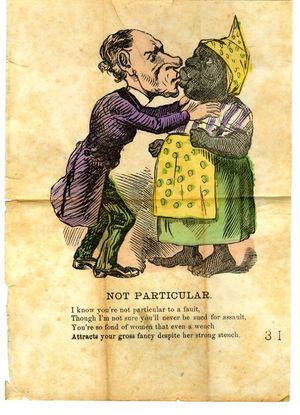قبل أدم
فرضية ما قبل أدم Pre-Adamite hypothesis أو ما قبل الأدمية Pre-adamism هو اعتقاد أن البشر (أو مخلوقات ذكية لكن غير بشرية) تواجد قبل الشخصية التوراتية أدم. هذا الافتراض يتناقض مع المعتقدات التي تصف أدم بأنه أول البشر، كما هو مذكور في التوراة وفي القرآن. Pre-adamism is therefore distinct from the conventional Abrahamic belief that Adam was the first human. Advocates of this hypothesis are known as "pre-Adamites", along with the humans who they believe existed before Adam. Pre-adamism has a long history, probably originating in early pagan responses to Abrahamic claims regarding the origins of the human race.
تاريخ وتطور الفرضية
التطور المبكر
The first known debate about human antiquity took place in 170 AD between Theophilus of Antioch and an Egyptian pagan "Apollonius the Egyptian" (probably Apollonius Dyscolus), who argued that the world was 153,075 years old.

1000 – 1700
The Kitab al Khazari (c. 1130–1140), a book by Judah ben Samuel Halevi, features a debate between the King of the Khazars and three theologians, a Jew, a Christian, and a Muslim, in which the King attempts to find out which is the true religion. The King asks the Jew whether he is concerned that the Indians claim to have buildings and artifacts that are millions of years old. The rabbi dismisses these beliefs as unworthy ideas held by a dissolute and unreliable people with no fixed form of religion, or no book "concerning which multitude of people held the same opinion".
In this same work Halevi attacked a number of ideas that appeared in a book titled Nabatean Agriculture, written or translated by Ibn Wahshiyya in 904. The ideas, attributed to the Sabeans, were that people lived before Adam, that Adam had parents, and that he came from India. Halevi dismissed these notions simply by saying that these people did not know of the revelation contained in Scripture.
The presence of a belief in the existence of men before Adam among the Familists, a religious community in Friesland, was noted by John Rogers in 1578.[1]
In 1591, Giordano Bruno argued that, because no one could imagine that the Jews and the Ethiopians had the same ancestry, God must have either created separate Adams or that Africans were the descendants of pre-Adamic races.[2]
The claims in Nabatean Agriculture mentioned above were also discussed by Maimonides (1135–1204) in his Guide for the Perplexed. Through Maimonides, they became known to the 17th-century French Millenarian Isaac La Peyrère, who, because of his influence on subsequent thinkers and movements, is usually credited with formulating the pre-Adamite theory. In his Prae-Adamitae, published in Latin in 1655, La Peyrère argued that Paul's words in Romans 5:12-14 should be interpreted to mean that "if Adam sinned in a morally meaningful sense there must have been an Adamic law according to which he sinned. If law began with Adam, there must have been a lawless world before Adam, containing people".[3] Thus, according to La Peyrère, there must have been two creations; first the creation of the gentiles and then the creation of Adam, who was the father of the Hebrews. The existence of pre-Adamites, La Peyrère argued, explained Cain's taking of a wife and the building of a city after Abel's murder in the Genesis account. This account of human origins became the basis for 19th century theories of polygenism and modern racism.[بحاجة لمصدر]
Some[من؟] date the origins of this racial theory precisely to 24 April 1684, when François Bernier distinguished four or five races (with no hierarchical distinction between them) in an article titled ("A new division of the Earth, according to the different species or races of men who inhabit it") published in the Journal des sçavans.[4] Because of widespread theological opposition to the pre-Adamite theories of his friend La Peyrère, Bernier published his paper anonymously.[5]
عصر النهضة
عصر التنوير
During the Age of Enlightenment, pre-Adamism was adopted widely as a challenge to the biblical account of human origins, whereas in the 19th century, the idea was welcomed by advocates of white superiority. A number of racist interpretive frameworks involving the early chapters of Genesis arose from pre-Adamism. Some pre-Adamite theorists held the view that Cain left his family for an inferior tribe described variously as "white Mongols" or that Cain took a wife from one of the inferior pre-Adamic peoples.[بحاجة لمصدر] The idea that Cain’s mark was blackness arose in 18th-century Europe and it was also popular in 19th-century America.[6]
في الصوفية
Various Sufis, especially سلطان باهو, a famous seventeenth century mystic of الطريقة القادرية الصوفية، advocated this theory. In one of his writings he writes "Once God said to the Prophet "O Muhammad I created an Adam before I created your father Adam, whom I gave a life of thousand years. Then I created fifteen thousand Adams all of whom I gave a life of ten thousand years. After that I created your Adam."[7]
According to this statement the Pre-Adamic era lasted for one hundred fifty million, one thousand years.
القرن 19
آخرون
انظر أيضاً
الهامش
- ^ Almond, 1999, p. 51.
- ^ Graves, 2003, p. 25.
- ^ Almond, 1999, p. 53.
- ^ The full title of the paper was "Nouvelle Division De La Terre, pour les differente Especes ou Races d'hommes qui l'habitent, envoyée par un fameux voyageur à M. l'Abbé de la **** à peu prés on ces termes", Journal des sçavans, 24 April 1684, pp. 133-140. The title is slightly different in the 1685 reprint in Journal des sçavans pour l'année M.DC.XXXIV, pp. 148-155 - see Boulle, 2003, pp. 11-27.
- ^ Flood, 2003, pp. 52-53.
- ^ Haynes, 2002, p. 15.
- ^ عين الفقر، بقلم سلطان باهو صفحة 285
المراجع والاستزادة
- Duncan, Isabella (1860). Pre-Adamite man : or, the story of our old planet & its inhabitants, told by Scripture & science.. London : Saunders, Otley, and Co. (Originally published anonymously, but known subsequently that the author was the wife of George John C. Duncan, the son of Henry Duncan.)
- Flood, Gavin (2003). The Blackwell Companion to Hinduism. Oxford: Blackwell Publishing. ISBN 0-631-21535-2
- Frederickson, George M. (1987). The Black Image in the White Mind. Wesleyan University Press. ISBN 0-8195-6188-6
- Graves, Joseph L. (2003). The Emperor's New Clothes: Biological Theories of Race at the Millennium. Newark, NJ: Rutgers University Press. ISBN 0-8135-3302-3
- Haynes, Stephen R. (2002). Noah's Curse: The Biblical Justification of American Slavery. New York, NY: Oxford University Press. ISBN 0-19-514279-9
- Harvey, Paul (2005). Freedom's Coming : Religious Culture and the Shaping of the South from the Civil War through the Civil Rights Era. UNC Press. ISBN 0-8078-2901-3
- Livingstone, David N. (2008). Adam’s ancestors : race, religion, and the politics of human origins. Johns Hopkins University Press. ISBN 978-0-8018-8813-7.
- Popkin, Richard Henry (1992). Third Force in Seventeenth-Century Thought. Brill Academic Publishers. ISBN 90-04-09324-9
- Smith, Christian (2003). The Secular Revolution. University of California Press. ISBN 0-520-23000-0
- Swain, Carol M. (2002). The New White Nationalism in America: Its Challenge to Integration. Cambridge: Cambridge University Press. ISBN 0-521-80886-3
- Almond, Philip C. (1999). Adam and Eve in Seventeenth-Century Thought. Cambridge: Cambridge University Press. ISBN 0-521-66076-9
- Barkun, Michael (1996). Religion and the Racist Right: The Origins of the Christian Identity Movement. UNC Press. ISBN 0-8078-4638-4
وصلات خارجية
- A.J. Maas, "Preadamites", Catholic Encyclopedia (1911) : Catholic view
- "Neanderthal Man: Pre-Adamite, Co-Adamite, or Adamite?", 29 Creation Research Society Quarterly (Mar. 1993) : Protestant creation science view
- Hugh W. Nibley, "Before Adam", Provo, Utah: Maxwell Institute : Latter-day Saint view





